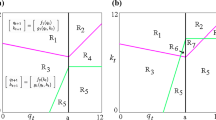Abstract
While the Walrasian price tâtonnement represents the traditional dynamic process in the general equilibrium context with and without production, Walras and other classics designed the process exclusively for pure exchange economies. In productive economies, the short-run output adjustment of existing firms and the entry/exit of firms should be modeled as well. So-called cross-dual processes which represent the classical approach to the dynamics of productive economies are discussed and extended. Complex motion can emerge in a discrete-time version of the original two-dimensional system when the aggregate demand function has a non-standard shape. A simultaneous process of price and short-run quantity adjustment with free entry and exit of competitive firms in a single market with a continuum of firms can generate closed orbits via a Hopf bifurcation when the slope of the demand function is positive at equilibrium. When the continuum economy is replaced by an economy with a finite number of firms, noisy limit cycles and complicated behavior can be observed.
Similar content being viewed by others
References
K.J. Arrow, Toward a theory of price adjustment, in:The Allocation of Economic Resources, ed. M. Abramowitz (Stanford University Press, Stanford, 1959) pp. 41–51.
K.J. Arrow and L. Hurwitz, On the stability of the competitive equilibrium. I, Econometrica 26(1958)522–552.
R. Aumann, Markets with a continuum of traders, Econometrica 32(1964)39–50.
M.J. Beckmann and H.E. Ryder, Simultaneous price and quantity adjustment in a single market, Econometrica 37(1969)470–484.
J.P. Benassy,The Economics of Market Disequilibrium (Academic Press, New York, 1982).
V. Böhm,Disequilibrium and Macroeconomics (Basil, Oxford, 1989).
D.G. Davies, A note on Marshallian versus Walrasian stability conditions, Can. J. Econ. Political Sci. 29(1963)535–540.
G. Debreu, Excess demand functions, J. Math. Econ. 1(1974)15–23.
G. Dumenil and D. Levy, The dynamics of competition: A restoration of the classical analysis, Cambridge J. Econ. 11(1987)133–164.
P. Flaschel, Stability — independent of economic structure? A prototype analysis, Mimeo, University of Bielefeld, (1989).
P. Flaschel and W. Semmler, Classical and neoclassical competitive adjustment processes, The Manchester School 55(1987)13–37.
P. Flaschel and W. Semmler, On the integration of dual and cross-dual adjustment processes in Leontief systems, Ricerche Economiche 12(1988)403–432.
W. Fukuda, The output adjustment mechanism in a multisectoral economy, Kobe University Econ. Rev. 21(1975)53–62.
G. Gandolfo, G. Martinengo and P.C. Padoan,Qualitative Analysis and Econometric Estimation of Continuous Time Dynamic Models (North-Holland, Amsterdam, 1981).
R.M. Goodwin, Static and dynamic general equilibrium models (1953). Reprinted in: R.M. Goodwin,Essays in Linear Economic Structures (MacMillan, London, 1983).
R.M. Goodwin,Elementary Economics from the Higher Standpoint (Cambridge University Press, Cambridge, 1970).
F. Hahn, Stability, in:Handbook of Mathematical Economics, Vol. 2, ed. K.J. Arrow and M.D. Intriligator (North-Holland, Amsterdam, 1984) pp. 745–793.
F. Hahn and T. Negishi, A theorem on non-tâtonnement stability, Econometrica 30(1962)463–469.
H. Haken,Advanced Synergetics (Springer, Berlin-Heidelberg-New York, 1983).
J.R. Hicks,Value and Capital, 2nd ed. (Clarendon Press, Oxford, 1946).
W. Hildenbrand, On the "Law of Demand", Econometrica 51(1983)997–1020.
H.-W. Lorenz,Nonlinear Dynamical Economics and Chaotic Motion (Springer, Berlin-Heidelberg-New York, 1989).
H.-W. Lorenz,Determinismus, nichtlineare Dynamik und wirtschaftliche Evolution (University of Göttingen, 1990).
F.R. Marotto, Snap-back repellers imply chaos in IRn, J. Math. Anal. Appl. 72(1978)199–223.
A. Marshall,Principles of Political Economy, 8th ed. (MacMillan, London, 1938).
A. Marshall, The pure theory of foreign trade (1879). Reprinted in:The Early Economic Writings of Alfred Marshall, 1867–1890, ed. J.K. Whitaker (MacMillan, London, 1975) pp. 117–181.
A. Mas-Colell, Notes on price and quantity tâtonnement dynamics, in:Models of Economic Dynamics, ed. H. Sonnenschein (Springer, Berlin-Heidelberg-New York, 1986) pp. 49–68.
A. Medio, Synergetics and dynamic economic models, in:Nonlinear Models of Fluctuating Growth, ed. R.M. Goodwin, M. Krüger and A. Vercelli (Springer, Berlin-Heidelberg-New York, 1984) pp. 166–191.
M. Morishima, A reconsideration of the Walras-Cassel-Leontief model of general equilibrium, in:Mathematical Models in the Social Sciences, ed. K.J. Arrow, S. Karlin and P. Suppes (Stanford University Press, Stanford, 1960), pp. 63–76.
P. Newman,The Theory of Exchange (Prentice-Hall, Englewood Cliffs, 1965).
W. Novshek and H. Sonnenschein, Quantity adjustment in an Arrow-Debreu-McKenzie type model, in:Models of Economic Dynamics, ed. H. Sonnenschein (Springer, Berlin-Heidelberg-New York, 1986) pp. 148–156.
W. Novshek and H. Sonnenschein, General equilibrium with free entry, J. Econ. Literature 25(1987)1281–1306.
P.A. Samuelson,Foundations of Economic Analysis (Harvard University Press, Cambridge, 1947).
W. Shafer and H. Sonnenschein, Market demand and excess demand functions, in:Handbook of Mathematical Economics, Vol. 2, ed. K.J. Arrow and M.D. Intriligator (North-Holland, Amsterdam, 1982) pp. 672–693.
H. Sonnenschein, Price dynamics and the disappearance of short-run profits, J. Math. Econ. 8(1981)201–206.
H. Sonnenschein, Price dynamics based on the adjustment of firms, Amer. Econ. Rev. 72(1982)1088–1096.
C. Sparrow, Bifurcation and chaotic behaviour in simple feedback systems, J. Theor. Biol. 83(1980)93–105.
L.E. Svensson, Walrasian and Marshallian stability, J. Econ. Theory 34(1984)371–379.
A. Takayama,Mathematical Economics (The Dryden Press, Hinsdale).
H. Uzawa, The stability of dynamic processes, Econometrica 29(1961)617–631.
D.A. Walker, Walras's theories of tâtonnement, J. Political Econ. 95(1987)758–774.
L. Walras,Elements of Pure Economics (George Allen and Unwin, London, 1954).
A. Wolf, J.B. Swift, H.L. Swinney and J.A. Vastano, Determining Lyapunov exponents from a time series, Physica 16D(1985)285–317.
Author information
Authors and Affiliations
Rights and permissions
About this article
Cite this article
Lorenz, HW. On the complexity of simultaneous price-quantity adjustment processes. Ann Oper Res 37, 51–71 (1992). https://doi.org/10.1007/BF02071048
Issue Date:
DOI: https://doi.org/10.1007/BF02071048




